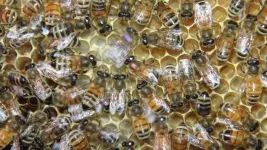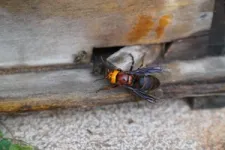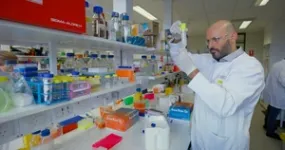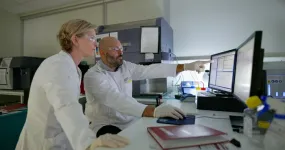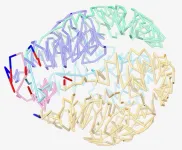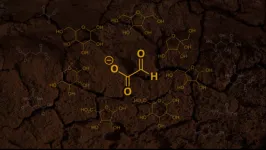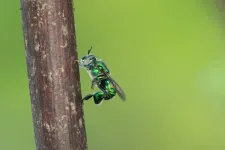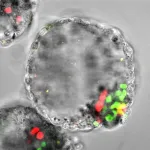Stop signals reduce dopamine levels and dancing in honeybees
2023-04-13
(Press-News.org)
Researchers from the Xishuangbanna Tropical Botanical Garden (XTBG) of the Chinese Academy of Sciences and the University of California San Diego have revealed that receiving an inhibitory signal (stop signal) associated with negative food conditions can decrease brain dopamine levels in dancing honeybees.
The study was published in Current Biology on April 13.
Dopamine is known as the feel-good neurotransmitter—a chemical that ferries information between neurons. In multiple animals, dopamine is involved in arousal, cognition, and sensitivity to stimuli. It is also associated with seeking and wanting behavior, particularly with the pleasurable experiences of reward.
Honeybees communicate to nestmates the location of resources by performing a waggle dance (i.e., a repetition of movements consisting of a waggle "run" and a return "run" that is unique to each particular resource location). Their behavior type is significantly correlated with dopamine levels in bee heads. Waggle dancers have significantly higher dopamine levels than all other bees.
Honeybees have a sophisticated mechanism for communicating peril. For example, foragers use the stop signal—an inhibitory signal targeted at waggle dancers—to warn of a dangerous or declining food source and to counteract the positive feedback generated by the waggle dance.
According to Dr. DONG Shihao of XTBG, it was unclear, however, how predators affected the honeybee food-wanting system.
"We were wondering whether a signal about danger at a food source could, by itself, decrease foraging motivation and thus reduce brain dopamine levels," said Dr. DONG.
The researchers decided to test the effects of predator threat on the waggle dance and stop signal. They observed that foragers produced no stop signals when they were not attacked. In contrast, when attacked by hornets, foragers completely ceased waggle dancing. Attacked bees also abandoned the dangerous feeder and spent more time in the hive. In both whole-colony and individual measurements, stop signaling sharply increased when bees were attacked by hornets.
"Our study provides the first evidence that receiving a signal associated with negative food conditions (the stop signal) is sufficient to decrease brain dopamine levels in waggle dancers, even when these dancers have not experienced peril," said Prof. TAN Ken from XTBG, corresponding author of the study.
Moreover, the researchers discovered that increasing bee dopamine levels reduced the aversiveness of hornet attacks. Bees that fed on dopamine sucrose solution spent significantly more time staying on the feeder after being attacked by a hornet, produced fewer stop signals when they returned to the hive, and performed more waggle dances than bees that were also attacked but fed pure sucrose solution. Therefore, the fear-inducing effects of an attack could be countered by pharmacologically increasing bee dopamine levels.
"Attacks by hornet predators can reduce brain dopamine levels and cause foragers to pass on such stressful information via stop signals that also reduce brain dopamine levels in recipients. Artificially increasing dopamine levels by feeding bees dopamine would reduce the aversive effects of hornet attacks," said Prof. TAN.
END
ELSE PRESS RELEASES FROM THIS DATE:
2023-04-13
About The Study: In this analysis of more than 5 million hospitalizations between 2020 and 2022, health care–associated infection (HAI) occurrence among inpatients without COVID-19 was similar to that during 2019 despite additional pressures for infection control and health care professionals. The findings suggest that patients with COVID-19 may be more susceptible to HAIs and may require additional prevention measures.
Authors: Kenneth E. Sands, M.D., M.P.H., of HCA Healthcare in Nashville, is the corresponding author.
To access the embargoed study: Visit our For The Media website at this link https://media.jamanetwork.com/
(doi:10.1001/jamanetworkopen.2023.8059)
Editor’s ...
2023-04-13
About The Study: The findings of this study including more than 3 million patients receiving the mRNA COVID-19 vaccine suggest that retinal vascular occlusion (RVO) diagnosed acutely after vaccination occurs extremely rarely at rates similar to those of two different historically used vaccinations, the influenza and tetanus, diphtheria, pertussis (Tdap) vaccines. No evidence suggesting an association between the mRNA COVID-19 vaccination and newly diagnosed RVO was found.
Authors: Rishi P. Singh, M.D., of ...
2023-04-13
In the run-up to the 2020 election, people appear to have become savvier in spotting misinformation online: clicks onto unreliable websites have declined, according to a new Stanford study published April 13 in the journal Nature Human Behaviour. According to prior research, some 44.3 percent of Americans visited websites during the 2016 U.S. election that repeatedly made false or misleading information.
During the 2020 election, Stanford scholars saw that number drop by nearly half to 26.2 percent.
While these findings ...
2023-04-13
Researchers at Curtin University have identified the genetic signature of pre-malignant liver cells, offering potentially significant implications for the almost 3,000 Australians diagnosed with the deadly cancer each year.
The study, published in the prestigious journal Cell Genomics, found that quantifying pre-malignant liver cells in patients with liver disease could help determine their future risk of developing liver cancer.
First author Dr Rodrigo Carlessi, from the Curtin Medical School and the Curtin Health Innovation Research Institute, said the discovery had the potential to save lives by changing how chronic liver disease patients ...
2023-04-13
Choosing a checkout line in a supermarket might seem like a no-brainer, but it can actually involve a complex series of cerebral computations. Maybe you count the number of shoppers in each line and pick the shortest, or estimate the number of items on each conveyor belt. Perhaps you quickly weigh up both shoppers and items and maybe even the apparent speed of the cashier... In fact, there are a multiplicity of strategies for solving this problem.
So how does the brain know how to make decisions ...
2023-04-13
RIVERSIDE, Calif. -- 'Tis the season for hiking now that spring has arrived and temperatures are on the upswing. But with hikes come insect bites and on the increase in North America is babesiosis, a malaria-like disease spread especially between May and October by a tick.
Indeed, recent research suggests an increase in the incidence of diseases transmitted by ticks around the world, not just the United States and Canada, due likely to climate change and other environmental factors. Among the tick-borne pathogens, Babesia parasites, which infect and destroy red blood cells, are considered a serious ...
2023-04-13
LA JOLLA, CA— Two prominent origin-of-life chemists have published a new hypothesis for how the first sugars—which were necessary for life to evolve—arose on the early Earth.
In a paper that appeared on April 13, 2023, in the journal Chem, the chemists from Scripps Research and the Georgia Institute of Technology propose that key sugars needed for making early life forms could have emerged from reactions involving glyoxylate (C2HO3–), a relatively simple chemical that plausibly existed on the Earth before life evolved.
“We show that our new hypothesis has key advantages over the more traditional view ...
2023-04-13
Offshore wind farms in the North Sea reduce the population of loons –fish-eating aquatic birds also known as divers – by 94% within a one-kilometre zone, according to new research published in Scientific Reports. The findings highlight the need to minimise the impact of offshore wind farms on seabirds, while balancing this effort with the demand for renewable energy.
Previous research has found that different seabird species respond to offshore windfarms differently – they may avoid the area which can lead to habitat displacement or they may be attracted to the area which can increase mortality via collisions with the turbines. However, it is difficult ...
2023-04-13
Male bees display a remarkable passion for collecting scents: they deposit scents from various sources in special pockets on their hind legs, thus composing their own fragrance. This behaviour has been known since the 1960s. The reason why they do it has been the subject of much speculation just as long. Researchers from Ruhr University Bochum, Germany, in collaboration with colleagues from the University of California at Davis and the University of Florida at Fort Lauderdale, have finally solved the mystery. The bee fragrance serves as a sex attractant and increases the reproductive success of the males, as the team found out after three years ...
2023-04-13
A high-throughput single-cell single-mitochondrial genome sequencing technology known as iMiGseq has provided new insights into mutations of mitochondrial DNA (mtDNA) and offers a platform for assessing mtDNA editing strategies and genetic diagnosis of embryos prior to their implantation.
An international team of researchers, led by KAUST stem cell biologist Mo Li, has now quantitatively depicted the genetic maps of mtDNA in single human oocytes (immature eggs) and blastoids (stem cell-based synthetic embryos)[1]. This has revealed molecular features of rare mtDNA mutations that cause maternally inherited diseases.
Mitochondria, the ...
LAST 30 PRESS RELEASES:
[Press-News.org] Stop signals reduce dopamine levels and dancing in honeybees
